Introduction
There is expanding interest in the use of high tunnels for extended season tomato production in the central Midwest. High tunnels (hoop houses) are passive solar greenhouses or cold frames that are used to extend the traditional growing season for many horticulture crops. However, there is very little information on tomato cultivar performance within high tunnels. Growing conditions within a high tunnel can be significantly different from growing conditions typically encountered in field production. High tunnels increase the average 24 h temperature by as much as 15ºF (Jett, 2002). High tunnels also protect a crop from variable weather and pests and offer the opportunity to control the growing environment relative to field. The objective of this research was to evaluate the yield performance of several tomato cultivars within a high tunnel and in the field.
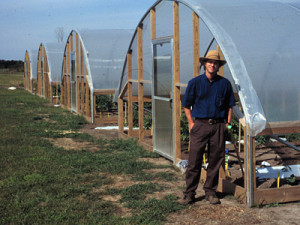
Lewis Jett in Columbia Missouri, notice sidewalls are rolled up.
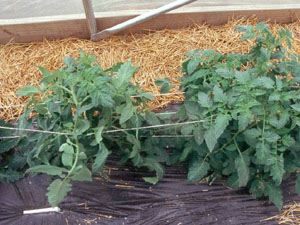
Plants are supported with the string weave method.
Materials and Methods
Four high tunnels (HT) (Stuppy Greenhouse Manufacturing Inc., North Kansas City, Missouri) were constructed in July 2001 at the University of Missouri Bradford Research and Education Center located near Columbia, Missouri (Lat. 38N, Long. 92W). The soil, a fine Mexico silt loam, montmorillonitic, mesic Mollic Endoaqualf, was tilled, graded, and leveled prior to construction. Soil samples were taken prior to planting and analyzed by the University of Missouri soil-testing laboratory.
Soil pH was 6.0, with approximately 2% organic matter. Each HT was 20’ (width) x 9’ (height) x 36’ (length) providing approximately 700 square feet of total planting space per house. Hoops were spaced six feet apart with one top purlin. For ventilation, a 39” high roll-up sidewall was used which extended the length of both sides of each high tunnel and was rolled up manually. Tunnels were built with the long axis oriented east west in order to intercept the areas prevailing south by southwest wind. Each tunnel was covered with a single layer of clear 6 mil plastic (K-50, Klerk’s Plastic Products Manufacturing Inc., Richburg, South Carolina). Field grown control plots were adjacent to the high tunnels. Tomato seeds from seven cultivars were seeded in late January 2002 for high tunnel evaluation and late February for field evaluations into standard germination trays filled with Pro-mix BX media (Hummert Intl. St. Louis, Missouri) and subsequently transplanted into Compack 606 trays (2 ¼” x 2” cell) at the 2-3 true leaf stage. Transplants were grown in the greenhouse for approximately 6 weeks and then prepared for transplanting into the high tunnel on March 24, 2002. One week prior to transplanting, the tomatoes were hardened off by exposing them to ambient temperatures for 3-4 hours each day.
High Tunnel Evaluations
The soil within the high tunnel was tilled, fertilized and ridged (4” height) prior to application of a 1 mil, embossed plastic mulch. Tomato plants in all treatments were spaced 24” (0.6 m) within row with 3’ (0.9 m) between rows resulting in 6 square feet per plant.
Plots were irrigated with at least one inch of water weekly through 8mil t-tape with 12” dripper spacing and a flow rate of 0.450 gpm (TSX-508, T-Systems International, San Diego, California). A granular 13N -13P -13K fertilizer was applied pre plant to all plots at the rate of 50-lbs per acre. Calcium nitrate (CaNO3) was applied weekly through the drip irrigation at a rate of 10 lbs per acre (1 g/m²) commencing two weeks after transplanting using a Dosatron fertilizer injector (40 gal per min) and continuing through harvest. Tomatoes were supported using the string weave method, with two tomato plants between each stake. Tomato cultivars evaluated were ‘Florida 47’, ‘Florida 91’, ‘Floralina’, ‘Merced’, ‘Carolina Gold’, ‘Brandywine’, ‘BHN 543’, and ‘Mt. Fresh’. ‘Florida 47’ is a vigorous determinate that ripens mid-season with very large fruit.
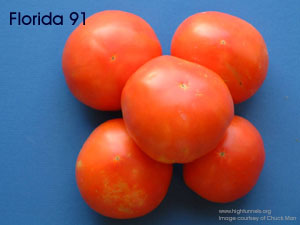 |
 |
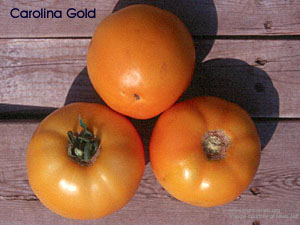 |
 |
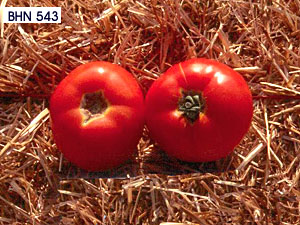 |
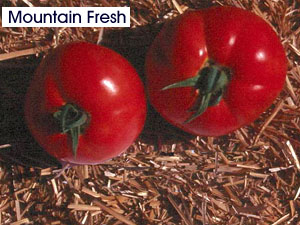 |
| ‘Floralina’ is a medium tall determinate with large fruit that ripens early to mid-season. ‘Florida 91’ is a medium determinate, heat tolerant, early to mid-season cultivar with large fruit. | ‘Merced’ is an early ripening determinate cultivar with large fruit. | ‘Carolina Gold’ is a tall determinate that ripens mid-season with large, yellow-colored fruit | ‘Brandywine’ is an heirloom cultivar with an indeterminate growth habit and large fruits that ripen late in the season. | ‘BHN 543’ is a medium tall determinate cultivar with large fruit ripening early to mid-season. | ‘Mt. Fresh’ is a tall determinate cultivar with large fruit that ripens mid-season. |
There were four replications for each treatment type arranged in a completely randomized block design. Plants were transplanted into rows of sixteen plants, with four plots per row. Each plot contained 4 plants. Plants were covered with row cover continuously until the first flowers appeared. During flowering, row covers were removed in the morning and replaced in the afternoon when the vents were closed. When the weather began warming, row covers were only used on evenings when the temperature dropped below 50°F (10°C). Sidewall vents were opened if the prevailing outside temperature was 60°F.
Field Evaluations
The tomato cultivars were transplanted into field plots in late April 2002. Cultural practices were similar to high tunnel treatments with the spacing being 2’ between plants and 5 feet between rows providing 10 square feet per plant.
Results and Discussion
In the central Midwest, there is a strong price premium for early tomatoes marketed before the first week in July. To document the level of this premium, we recorded wholesale tomato prices at the Central Missouri Produce Auction during 2002. The Central Missouri Produce Auction is a local wholesale outlet for many commercial vegetable growers in central Missouri. Supplies of greenhouse (ground culture or hydroponics) tomatoes become available starting in late April in Missouri. Wholesale prices remained relatively high through June, and then began to decline in July as field supplies increased (Figure
1). Figure 1. Wholesale tomato prices (US No. 1 Large: 2.5-2.75” diameter) per box (25 lb.). Source: Central Missouri Produce Auction, Versailles, MO. Prices and supply to the left of the line represent “early” prices.

High Tunnel Evaluations
Total early (i.e., before July 4) marketable yield from ‘BHN 43’, and ‘Merced’ were significantly greater than all other cultivars evaluated (Table 1).
Table 1. Early (6/14-7/4) marketable yield of tomato cultivars within a high tunnel.
|
Cultivar
|
Marketable Yield (lbs per plant)z
|
||
|
US No. 1
|
US No. 2
|
Total
|
|
| BHN 543 |
3.3a
|
1.2ab
|
4.5a
|
| Brandywine |
1.8cd
|
1.4a
|
3.2b
|
| Carolina Gold |
2.3a
|
0.8b
|
3.1b
|
| Floralina |
1.5d
|
1.4a
|
2.9b
|
| Florida 47 |
1.9cd
|
1.1ab
|
3.0b
|
| Florida 91 |
2.6abc
|
0.6b
|
3.2b
|
| Merced |
3.1ab
|
1.6a
|
4.7a
|
| Mt. Fresh |
1.9cd
|
0.6b
|
2.5b
|
z Means with the same letter are not significantly different LSD P< or = 0.05.
Early yield of US No. 1 fruit from ‘BHN 543’, ‘Merced’ and ‘Florida 91’ was significantly greater relative to the other cultivars evaluated. ‘Brandywine’, an indeterminate beefsteak cultivar, produced significantly less marketable fruit and had the highest percentage of unmarketable fruit. Culls from ‘Brandywine’ were mostly the result of radial fruit cracking and surface blemishes. ‘Brandywine’ also had internal white tissue from heat stress.
Figure 2. Cumulative marketable yields per plant (6/14-7/20) within a high tunnel.
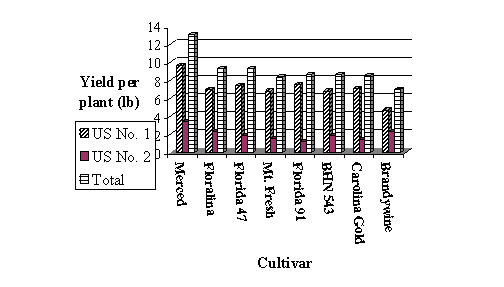
Field Evaluations
Tomatoes in field plots were harvested starting on July 25, 2002, and separated into marketable grade classes (Table 2).
Table 2. Field performance of tomato cultivars.
|
Cultivar
|
Marketable Yield (lbs per plant)z
|
||
|
US No. 1
|
US No. 2
|
Total
|
|
| BHN 543 |
6ab
|
1ns
|
7ns
|
| Brandywine |
4b
|
3ns
|
7ns
|
| Carolina Gold |
7ab
|
2ns
|
9ns
|
| Floralina |
8a
|
2ns
|
10ns
|
| Florida 91 |
7ab
|
2ns
|
9ns
|
| Merced |
4b
|
5ns
|
9ns
|
| Mt. Spring |
8a
|
5ns
|
13ns
|
| Mt. Fresh |
9a
|
3ns
|
12ns
|
z Means with the same letter are not significantly different LSD P< or = 0.05. NS=Not significant.
‘Merced’, ‘Floralina’, ‘BHN 543’, ‘Florida 91’ and ‘Carolina Gold’ had significantly higher marketable yields when grown within a high tunnel relative to the field. In addition, high tunnel tomatoes were more than 30 days earlier than field tomatoes. On an area basis, high tunnel tomatoes significantly out yielded field tomatoes
Figure 3. Comparison of yield per square foot of all tomato cultivars evaluated.

Conclusions
For growers interested in early tomato production, high tunnels seem to be an excellent technology to achieve this goal. Our research has documented significant yield enhancement from high tunnel production. Almost every cultivar that performs well in the field environment will excel in a high tunnel. Disease infestation and physiological ripening disorders such as yellow shoulder and sun scorch were negated by the high tunnel. Based on the results of this research, it is possible for a grower to have vine-ripe tomatoes from mid-June until October in the central Midwest by using high tunnels as a complement to field production.
Acknowledgements
The authors thank Rupp Seeds Inc., Wauseon, OH and Chesmore Seed, St. Joseph, Missouri for providing seed samples for this research.
About the Authors
- Lewis Jett is and Assistant Professor & State Vegetable Crops Specialist at Department of Horticulture, University of Missouri-Columbia, Columbia, Missouri 65211-7114.
- Andrew Read is a Graduate Research Assistant at Department of Horticulture, University of Missouri-Columbia.




